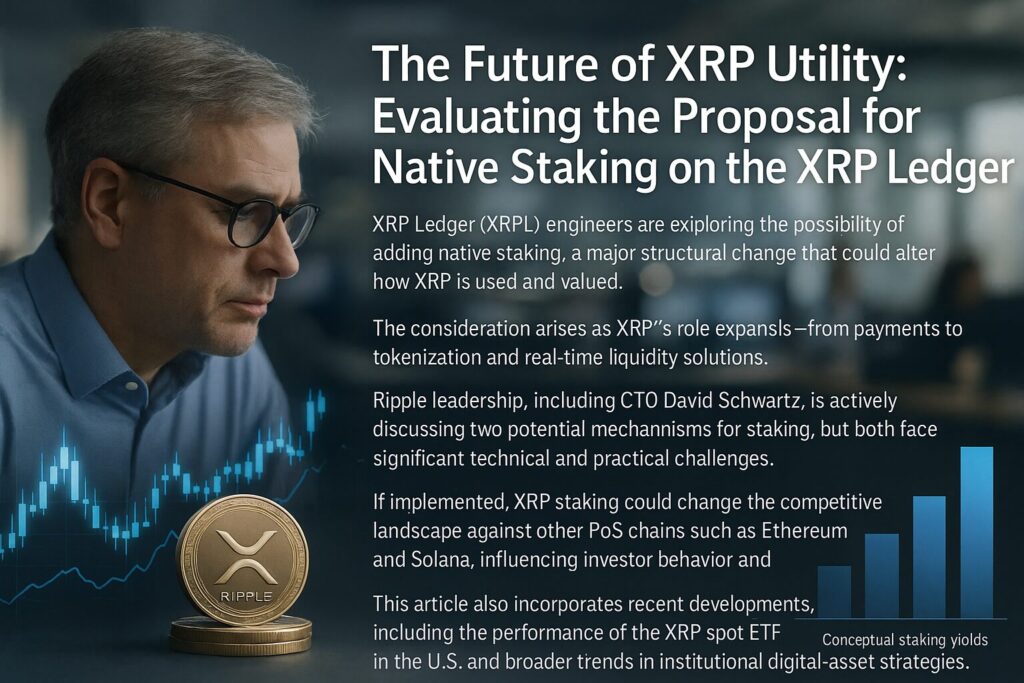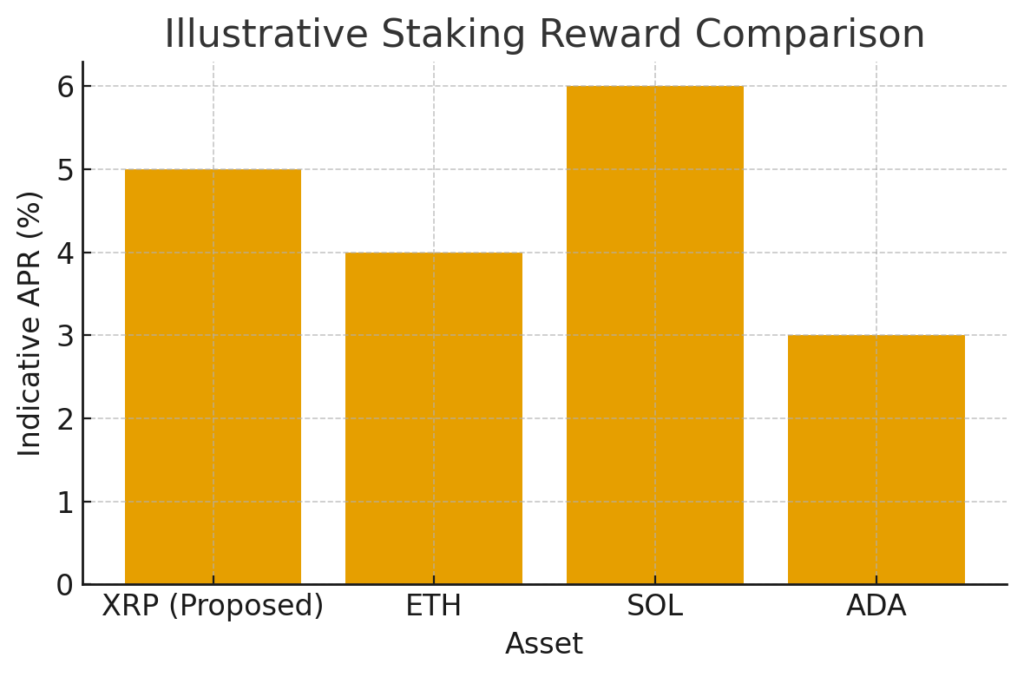
Main Points:
- XRP Ledger (XRPL) engineers are exploring the possibility of adding native staking, a major structural change that could alter how XRP is used and valued.
- The consideration arises as XRP’s role expands—from payments to tokenization and real-time liquidity solutions.
- Ripple leadership, including CTO David Schwartz, is actively discussing two potential mechanisms for staking, but both face significant technical and practical challenges.
- If implemented, XRP staking could change the competitive landscape against other PoS chains such as Ethereum and Solana, influencing investor behavior and institutional adoption.
- This article also incorporates recent developments, including the performance of the XRP spot ETF in the U.S. and broader trends in institutional digital-asset strategies.
- A conceptual chart comparing potential staking yields is included.
Introduction: Why the XRP Staking Debate Matters Now
The debate surrounding the introduction of native staking to the XRP Ledger (XRPL) has gained remarkable momentum within the global crypto community. J. Ayo Akinyele, the head of engineering at RippleX, recently indicated that Ripple’s engineering division is actively exploring whether a native staking mechanism could—or should—be added to XRPL. While the idea remains conceptual, its implications are far-reaching.
Staking, traditionally associated with Proof-of-Stake (PoS) blockchains such as Ethereum (ETH) and Solana (SOL), allows token holders to lock assets and contribute to network operations in exchange for rewards. Because XRPL uses a unique consensus algorithm (the Ripple Protocol Consensus Algorithm, or RPCA), staking has historically been absent from XRP’s economic design. Therefore, the very act of considering native staking represents a major potential evolution for XRP’s utility.
Akinyele’s public commentary arrives at a critical moment: XRP’s use cases and institutional influence are expanding rapidly. Tokenized asset settlement, corporate finance applications, and the recent launch of an XRP spot ETF in the U.S. have shifted the currency from a payment-focused asset into a multi-role instrument with increasing strategic relevance.
The Expanding Role of XRP: From Payments to Tokenized Finance
1. XRP’s Original Purpose
At its inception, XRP’s primary mission was simple and powerful: enable low-cost, high-speed cross-border settlement. The XRPL architecture was optimized for throughput, reliability, and energy-efficient validation, making it suitable for mission-critical financial operations.
2. Transition to Tokenization and On-Demand Liquidity
Akinyele points out that XRPL is now being used for far more than initial payment applications.
Today, XRPL facilitates:
- Tokenized asset settlements
- Real-time liquidity distribution
- Decentralized asset issuance
- Corporate and institutional finance products
These developments mirror a broader industry trend. Institutions are aggressively adopting asset tokenization as a way to unlock efficiencies, reduce settlement latency, and lower operational costs. XRPL’s speed and predictability make it an appealing candidate in this domain.
3. Institutional Expansion via ETFs and Corporate Adoption
The XRP spot ETF launched in the U.S. earlier this year has been a strong catalyst for renewed attention. Its first-day trading volume exceeded ¥9 billion (approx. $61 million), demonstrating robust demand from market participants searching for a regulated vehicle to gain exposure.
At the same time, new corporate entities built around XRP’s infrastructure have emerged, further solidifying the token’s presence in institutional financial strategy.
Why Staking Is Being Considered for XRP
A Natural Next Step in Expanding Utility
As XRP’s role expands, developers are exploring how to increase the asset’s functionality—and how to create new incentives for holders and developers. Akinyele explains that when searching for ways to elevate XRP’s utility, the idea of staking emerged naturally.
Staking could introduce:
- Yield opportunities for investors
- Sustainable incentives for network participants
- A richer DeFi ecosystem built on XRP
- Stronger alignment between token holders and system health
However, because XRPL is not a PoS chain, integrating staking requires much more than copying existing models from Ethereum or Solana.
Technical Requirements for Native XRP Staking
Akinyele identifies two core requirements:
1. A Reward Source
A system must specify where staking rewards come from.
Options might include:
- Protocol-level inflation
- Slashing or penalty redistribution
- Transaction-fee allocation
- Dedicated reward pools
Each has distinct trade-offs regarding fairness, inflation, and sustainability.
2. A Fair Mechanism for Reward Distribution
Rewards must be distributed in a transparent, tamper-resistant manner. This requires:
- Validator accountability
- Sybil-resistant identity management
- Predictable reward cycles
- Consensus-level design modifications
These constraints illustrate why Ripple’s engineers are approaching the topic cautiously.
David Schwartz’s Two Proposed Approaches
On November 19, Ripple CTO David Schwartz shared two conceptual strategies for enabling staking on XRPL. Both involve significant architectural changes:
Approach 1: A Two-Layer Consensus Model with Inner-Layer Incentives
This would introduce:
- An inner consensus layer where XRP holders receive incentives
- The existing RPCA consensus remaining as the outer layer
In theory, this could preserve XRPL’s low-energy design while adding reward mechanisms. But Schwartz warns that the complexity is non-trivial.
Approach 2: Zero-Knowledge Proofs with Transaction-Fee-Based Costs
This model would not modify RPCA. Instead:
- Users would perform zero-knowledge computations
- Their costs would be paid through transaction fees
- Rewards could be distributed based on provable participation
Zero-knowledge proofs (ZKPs) allow verifying “truth” without revealing underlying data. Their use in staking is still experimental across the industry.
Schwartz’s Conclusion: Technically Impressive, Practically Difficult
Despite the innovative designs, Schwartz emphasizes:
- These models may not be practical
- Implementation is unlikely in the near future
- Engineering challenges are significant
Still, the discussion itself signals a major philosophical shift about XRP’s future.
Industry Context: Rising Demand for Staking Assets
Staking Is Becoming a Standard Feature for Layer-1 Ecosystems
Recent data from institutional research firms highlights:
- Over $160 billion worth of assets are currently staked across global PoS networks
- ETH staking participation now exceeds 27% of total supply
- Staking yields range from 2–10%, depending on the chain
Investors increasingly expect staking yields as a counterpart to holding tokens long term. The lack of native staking on XRP makes it an outlier among major layer-1 ecosystems.
How XRP Staking Could Shift Competitive Positioning
Potential Benefits:
- XRP could attract yield-seeking investors
- XRPL could become more appealing for DeFi developers
- Liquidity providers could earn layered rewards
- Institutional structured products could emerge
Potential Risks:
- Inflation could weaken token economics if poorly designed
- Staking centralization could occur
- Complex consensus changes could introduce network risks
These considerations explain Ripple’s caution.
Recent Market Developments Relevant to XRP Staking
To contextualize XRP’s strategic direction, here are additional market trends:
1. Expansion of Real-World Asset (RWA) Tokenization
BlackRock, Franklin Templeton, and HSBC are scaling tokenization platforms. XRPL already supports tokenized assets efficiently, making staking an attractive complementary feature.
2. Growth of Liquidity Hubs and On-Demand Liquidity (ODL)
Ripple continues pushing ODL and automated liquidity solutions. Staking could help bootstrap liquidity pools and incentivize network participation.
3. Institutional Push Toward Yield-Bearing Digital Assets
Institutional investors increasingly seek regulated yield opportunities, especially in the U.S., Japan, and Singapore. If XRP introduces a compliant staking model, demand from ETFs, corporate treasuries, and liquidity providers could grow.Illustrative Chart: Potential Staking APR Comparison

This chart is illustrative, not predictive, and is designed to help readers visualize where XRP could position itself relative to existing ecosystems.
Could Native Staking Transform XRP’s Market Perception?
If staking is implemented, XRP could experience:
- Higher demand from long-term investors
- New DeFi opportunities, including lending, governance, and liquidity markets
- New business models for enterprises building on XRPL
- More diverse economic layers, enabling protocol-level sustainability
However, all of this hinges on overcoming the technical challenges described earlier.
Conclusion: A Turning Point for XRP’s Technical and Economic Future
The exploration of native staking marks a potential turning point for the XRP Ledger. While no decision has been made, the discussions led by Akinyele and Schwartz underscore the community’s growing ambition to expand XRP’s utility beyond payments. With institutional adoption increasing, an XRP ETF live in the U.S., and XRPL’s evolving role in tokenization and real-world liquidity, the case for staking is stronger today than ever before.
Yet the challenge is equally substantial. XRPL’s unique consensus design means staking cannot simply be ported from existing PoS models. Any staking solution must ensure fairness, sustainability, and security—without compromising XRPL’s core strengths.
For investors, builders, and institutions searching for new opportunities in blockchain utility, the evolution of XRP staking is a development that warrants close attention. If successfully implemented, native staking could reshape XRP’s competitive position and reinforce its role in the future of digital finance.

